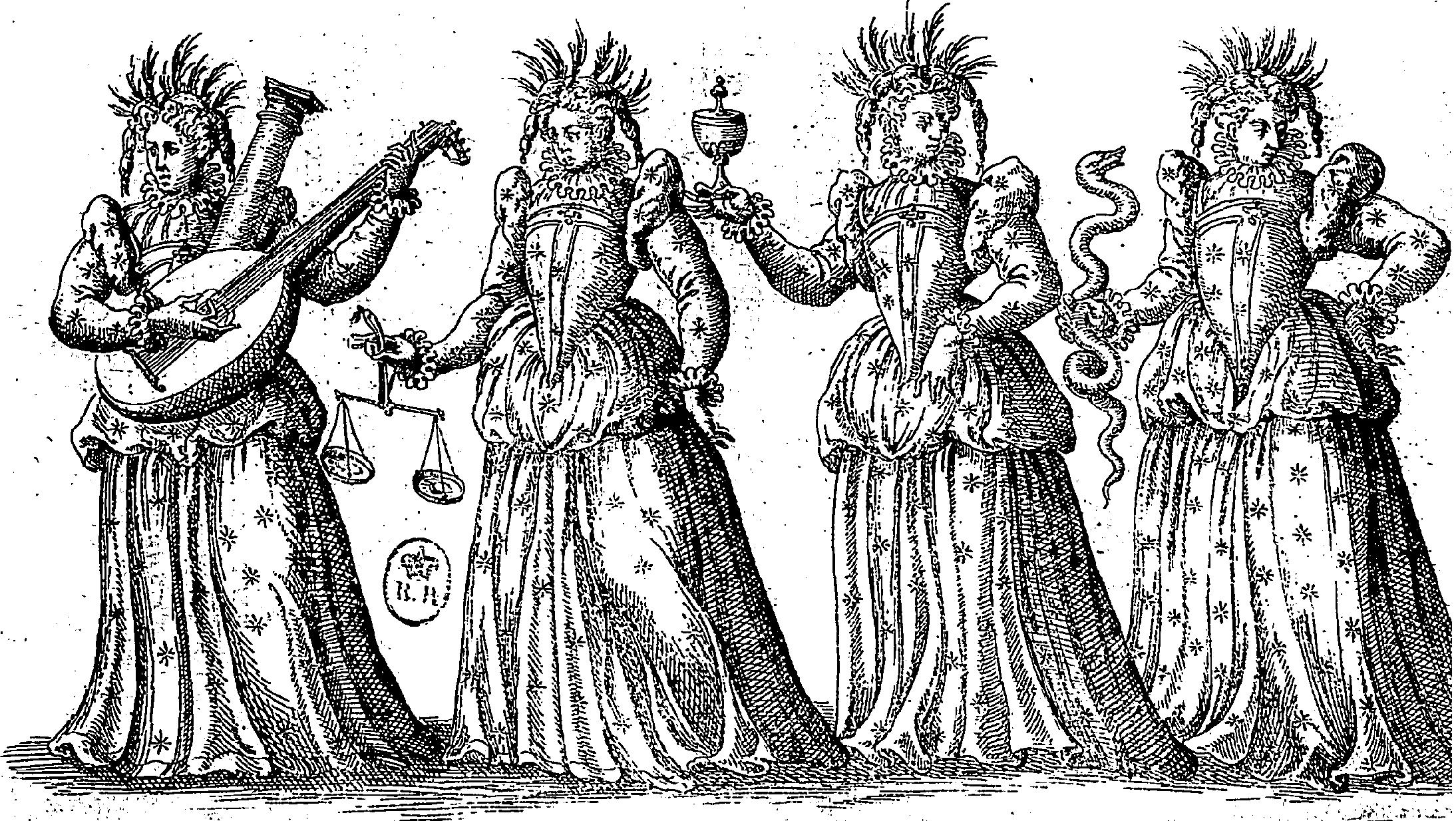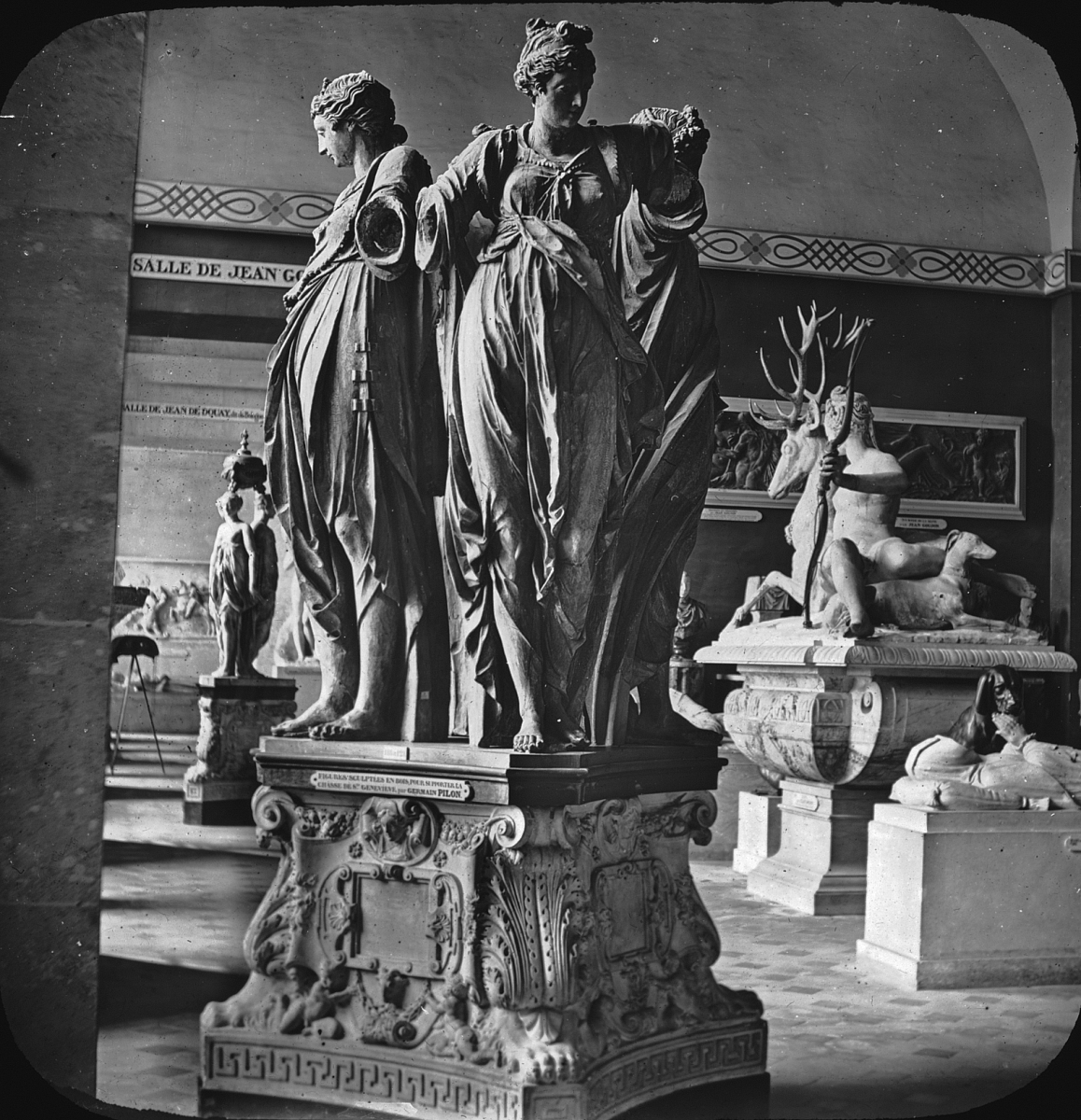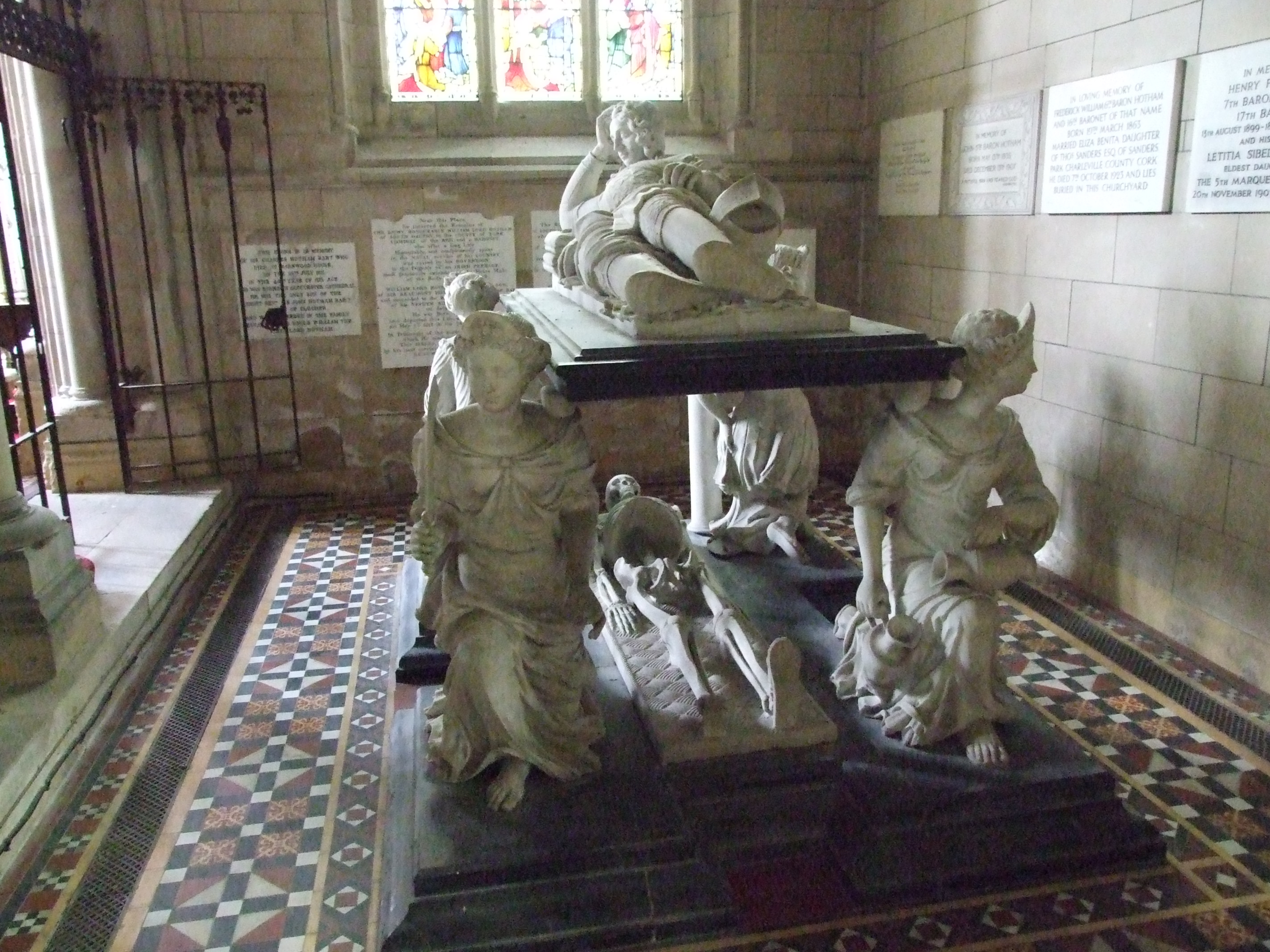Cardinal virtues on:
[Wikipedia]
[Google]
[Amazon]
 The cardinal virtues are four
The cardinal virtues are four


 The Cardinal Virtues are often depicted as female allegorical figures and were a popular subject for funerary sculpture. The attributes and names of these figures may vary according to local tradition.
In many churches and artwork the Cardinal Virtues are depicted with symbolic items:
* Justice
*: – sword, balance and scales, a crown
* Temperance
*: – wheel, bridle and reins, vegetables and fish, cup, water and wine in two jugs
* Fortitude
*: – armor, club, with a lion, palm, tower, a
The Cardinal Virtues are often depicted as female allegorical figures and were a popular subject for funerary sculpture. The attributes and names of these figures may vary according to local tradition.
In many churches and artwork the Cardinal Virtues are depicted with symbolic items:
* Justice
*: – sword, balance and scales, a crown
* Temperance
*: – wheel, bridle and reins, vegetables and fish, cup, water and wine in two jugs
* Fortitude
*: – armor, club, with a lion, palm, tower, a
virtues
Virtue ( la, virtus) is moral excellence. A virtue is a trait or quality that is deemed to be morally good and thus is valued as a foundation of principle and good moral being. In other words, it is a behavior that shows high moral standard ...
of mind and character in both classical philosophy
This page lists some links to ancient philosophy, namely philosophical thought extending as far as early post-classical history ().
Overview
Genuine philosophical thought, depending upon original individual insights, arose in many cultures ...
and Christian theology. They are prudence, justice
Justice, in its broadest sense, is the principle that people receive that which they deserve, with the interpretation of what then constitutes "deserving" being impacted upon by numerous fields, with many differing viewpoints and perspective ...
, fortitude, and temperance. They form a virtue theory of ethics. The term ''cardinal'' comes from the Latin (hinge); virtues are so called because they are regarded as the basic virtues required for a virtuous life.
These principles derive initially from Plato
Plato ( ; grc-gre, Πλάτων ; 428/427 or 424/423 – 348/347 BC) was a Greek philosopher born in Athens during the Classical period in Ancient Greece. He founded the Platonist school of thought and the Academy, the first institution ...
in '' Republic'' Book IV, 426–435. Aristotle
Aristotle (; grc-gre, Ἀριστοτέλης ''Aristotélēs'', ; 384–322 BC) was a Greek philosopher and polymath during the Classical period in Ancient Greece. Taught by Plato, he was the founder of the Peripatetic school of ph ...
expounded them systematically in the Nicomachean Ethics. They were also recognized by the Stoics. Cicero
Marcus Tullius Cicero ( ; ; 3 January 106 BC – 7 December 43 BC) was a Roman statesman, lawyer, scholar, philosopher, and academic skeptic, who tried to uphold optimate principles during the political crises that led to the esta ...
expanded on them, and Ambrose, Augustine of Hippo, and Thomas Aquinas
Thomas Aquinas, OP (; it, Tommaso d'Aquino, lit=Thomas of Aquino; 1225 – 7 March 1274) was an Italian Dominican friar and priest who was an influential philosopher, theologian and jurist in the tradition of scholasticism; he is known wit ...
adapted them while expanding on the theological virtues
Theological virtues are virtues associated in Christian theology and philosophy with salvation resulting from the grace of God. Virtues are traits or qualities which dispose one to conduct oneself in a morally good manner. Traditionally they hav ...
.
Four cardinal virtues
* Prudence (, ; la, prudentia; alsoWisdom
Wisdom, sapience, or sagacity is the ability to contemplate and act using knowledge, experience, understanding, common sense and insight. Wisdom is associated with attributes such as unbiased judgment, compassion, experiential self-knowle ...
, '' Sophia'', ), the ability to discern the appropriate course of action to be taken in a given situation at the appropriate time, with consideration of potential consequences.
* Justice
Justice, in its broadest sense, is the principle that people receive that which they deserve, with the interpretation of what then constitutes "deserving" being impacted upon by numerous fields, with many differing viewpoints and perspective ...
(, ; la, iustitia): also considered as fairness; the Greek word also having the meaning righteousness
* Fortitude (, ; la, fortitudo): also termed courage: forbearance, strength, endurance, and the ability to confront fear, uncertainty, and intimidation
* Temperance (, ; la, temperantia): also known as restraint, the practice of self-control, abstention, discretion, and moderation tempering the appetition. Plato considered , which may also be translated as sound-mindedness, to be the most important virtue.
Antiquity
The four cardinal virtues appeared as a group (sometimes included in larger lists) long before they were later given this title.Hellenistic philosophy
Plato identified the four cardinal virtues with the classes of the city described in '' The Republic'', and with the faculties of man. Plato narrates a discussion of the character of a good city where the following is agreed upon. '' Temperance'' was common to all classes, but primarily associated with the producing classes, the farmers and craftsmen, and with the animal appetites, to whom no special virtue was assigned. '' Fortitude'' was assigned to the warrior class and to the spirited element in man. '' Prudence'' was assigned to the rulers and to reason. ''Justice
Justice, in its broadest sense, is the principle that people receive that which they deserve, with the interpretation of what then constitutes "deserving" being impacted upon by numerous fields, with many differing viewpoints and perspective ...
'' stands outside the class system and divisions of man, and rules the proper relationship among the three of them.
Plato sometimes lists holiness (, , ) amongst the cardinal virtues. He especially associates holiness with justice, but leaves their precise relationship unexplained.
In Aristotle's '' Rhetoric'', we read:
They are expounded fully in the Nicomachean Ethics III.6 — V.2
Philo of Alexandria
Philo of Alexandria (; grc, Φίλων, Phílōn; he, יְדִידְיָה, Yəḏīḏyāh (Jedediah); ), also called Philo Judaeus, was a Hellenistic Jewish philosopher who lived in Alexandria, in the Roman province of Egypt.
Philo's de ...
, a Hellenistic Jewish philosopher, also recognized the four cardinal virtues as prudence, temperance, courage, and justice. In his writings, he states:
These virtues, according to Philo, serve as guiding principles for a virtuous and fulfilling life. Roman philosophy
The Roman philosopher and statesman Cicero (106–43 BC), like Plato, limits the list to four virtues: Cicero discusses these further in '' De Officiis'' (I, V and following). The Roman EmperorMarcus Aurelius
Marcus Aurelius Antoninus (Latin: áːɾkus̠ auɾέːli.us̠ antɔ́ːni.us̠ English: ; 26 April 121 – 17 March 180) was Roman emperor from 161 to 180 AD and a Stoic philosopher. He was the last of the rulers known as the Five Good ...
discusses these in Book V:12 of ''Meditations
''Meditations'' () is a series of personal writings by Marcus Aurelius, Roman Emperor from AD 161 to 180, recording his private notes to himself and ideas on Stoic philosophy.
Marcus Aurelius wrote the 12 books of the ''Meditations'' in Koine ...
'' and views them as the "goods" that a person should identify in one's own mind, as opposed to "wealth or things which conduce to luxury or prestige".
In the Bible
The cardinal virtues are listed in the deuterocanonical bookWisdom of Solomon
The Book of Wisdom, or the Wisdom of Solomon, is a Jewish work written in Greek and most likely composed in Alexandria, Egypt. Generally dated to the mid-first century BCE, the central theme of the work is "wisdom" itself, appearing under two p ...
, which in 8:7 reads:
They are also found in other non-canonical scriptures like 4 Maccabees
4 Maccabees, el, Μακκαβαίων Δʹ, translit=Makkabaíōn 4 also called the Fourth Book of Maccabees and possibly originally known as On the Sovereignty of Reason, el, περί αύτοκράτορος λογισμού, translit=Perí áf ...
1:18–19, which relates:
In the New Testament
Wisdom
Wisdom, sapience, or sagacity is the ability to contemplate and act using knowledge, experience, understanding, common sense and insight. Wisdom is associated with attributes such as unbiased judgment, compassion, experiential self-knowle ...
, usually '' Sophia,'' rather than prudence, is discussed extensively in all parts of the New Testament. It is a major topic of 1 Corinthians 2, where the author discusses how divine teaching and power are greater than worldly wisdom.
Justice
Justice, in its broadest sense, is the principle that people receive that which they deserve, with the interpretation of what then constitutes "deserving" being impacted upon by numerous fields, with many differing viewpoints and perspective ...
(, ) is taught extensively in the gospels, where most translators give it as "righteousness".
Plato's word for Fortitude () is not present in the New Testament, but the virtues of steadfastness (, ) and patient endurance (, ) are highly praised.
Temperance (, ), usually translated "sobriety," is present in the New Testament, along with self-control (, ).
In Christian tradition
Catholic moral theology
Catholic moral theology is a major category of doctrine in the Catholic Church, equivalent to a religious ethics. Moral theology encompasses Catholic social teaching, Catholic medical ethics, sexual ethics, and various doctrines on individua ...
drew from both the Wisdom of Solomon and the Fourth Book of Maccabees in developing its thought on the virtues. Ambrose () was the first to use the expression "cardinal virtues":
Augustine of Hippo, discussing the morals of the church, described them:

In relation to the theological virtues
The "cardinal" virtues are not the same as the three theological virtues: Faith, Hope, and Charity (Love
Love encompasses a range of strong and positive emotional and mental states, from the most sublime virtue or good habit, the deepest interpersonal affection, to the simplest pleasure. An example of this range of meanings is that the love o ...
), named in 1 Corinthians 13.
Because of this reference, a group of seven attributes is sometimes listed by adding the four cardinal virtues (prudence, temperance, fortitude, justice) and three theological virtues (faith, hope, charity).
Together, they compose what is known as the seven virtues. While the first four date back to Greek
Greek may refer to:
Greece
Anything of, from, or related to Greece, a country in Southern Europe:
*Greeks, an ethnic group.
*Greek language, a branch of the Indo-European language family.
**Proto-Greek language, the assumed last common ancestor ...
philosophers and were applicable to all people seeking to live moral lives, the ''theological virtues'' appear to be specific to Christians
Christians () are people who follow or adhere to Christianity, a monotheistic Abrahamic religion based on the life and teachings of Jesus Christ. The words '' Christ'' and ''Christian'' derive from the Koine Greek title ''Christós'' (Χρ ...
as written by Paul in the New Testament
The New Testament grc, Ἡ Καινὴ Διαθήκη, transl. ; la, Novum Testamentum. (NT) is the second division of the Christian biblical canon. It discusses the teachings and person of Jesus, as well as events in first-century Chri ...
.
Efforts to relate the cardinal and theological virtues differ. Augustine sees faith as coming under justice. Beginning with a wry comment about the moral mischief of pagan deities, he writes:
Dante Alighieri
Dante Alighieri (; – 14 September 1321), probably baptized Durante di Alighiero degli Alighieri and often referred to as Dante (, ), was an Italian poet, writer and philosopher. His ''Divine Comedy'', originally called (modern Italian: '' ...
also attempts to relate the cardinal and theological virtues in his Divine Comedy
The ''Divine Comedy'' ( it, Divina Commedia ) is an Italian narrative poem by Dante Alighieri, begun 1308 and completed in around 1321, shortly before the author's death. It is widely considered the pre-eminent work in Italian literature ...
, most notably in the complex allegorical scheme drawn in ''Purgatorio'' XXIX to XXXI. Depicting a procession in the Garden of Eden (which the author situates at the top of the mountain of purgatory), Dante describes a chariot drawn by a gryphon and accompanied by a vast number of figures, among which stand three women on the right side dressed in red, green and white, and four women on the left, all dressed in red. The chariot is generally understood to represent the holy church, with the women on left and right representing the theological and cardinal virtues respectively. The exact meaning of the allegorical women's role, behaviour, interrelation and color-coding remains a matter of literary interpretation.
In relation to the seven deadly sins
In the High Middle Ages, some authors opposed the seven virtues (cardinal plus theological) to theseven deadly sins
The seven deadly sins, also known as the capital vices or cardinal sins, is a grouping and classification of vices within Christian teachings. Although they are not directly mentioned in the Bible, there are parallels with the seven things ...
. However, “treatises exclusively concentrating on both septenaries are actually quite rare.” and “examples of late medieval catalogues of virtues and vices which extend or upset the double heptad can be easily multiplied.” And there are problems with this parallelism:
Contemporary thought
Jesuit scholars Daniel J. Harrington and James F. Keenan, in their ''Paul and Virtue Ethics'' (2010), argue for seven "new virtues" to replace the classical cardinal virtues in complementing the three theological virtues, mirroring the seven earlier proposed inBernard Lonergan
Bernard Joseph Francis Lonergan (17 December 1904 – 26 November 1984) was a Canadian Jesuit priest, philosopher, and theologian, regarded by many as one of the most important thinkers of the 20th century.
Lonergan's works include ''Insight: A ...
's ''Method in Theology'' (1972): "be humble, be hospitable, be merciful, be faithful, reconcile, be vigilant, and be reliable".
Allegory

 The Cardinal Virtues are often depicted as female allegorical figures and were a popular subject for funerary sculpture. The attributes and names of these figures may vary according to local tradition.
In many churches and artwork the Cardinal Virtues are depicted with symbolic items:
* Justice
*: – sword, balance and scales, a crown
* Temperance
*: – wheel, bridle and reins, vegetables and fish, cup, water and wine in two jugs
* Fortitude
*: – armor, club, with a lion, palm, tower, a
The Cardinal Virtues are often depicted as female allegorical figures and were a popular subject for funerary sculpture. The attributes and names of these figures may vary according to local tradition.
In many churches and artwork the Cardinal Virtues are depicted with symbolic items:
* Justice
*: – sword, balance and scales, a crown
* Temperance
*: – wheel, bridle and reins, vegetables and fish, cup, water and wine in two jugs
* Fortitude
*: – armor, club, with a lion, palm, tower, a yoke
A yoke is a wooden beam sometimes used between a pair of oxen or other animals to enable them to pull together on a load when working in pairs, as oxen usually do; some yokes are fitted to individual animals. There are several types of yoke, u ...
, a broken column
* Prudence
*: – book, scroll, mirror, (occasionally) an attacking serpent
Notable depictions include sculptures on the tomb of Francis II, Duke of Brittany and the tomb of John Hotham. They were also depicted in the garden at Edzell Castle
Edzell Castle is a ruined 16th-century castle, with an early-17th-century walled garden. It is located close to Edzell, and is around north of Brechin, in Angus, Scotland. Edzell Castle was begun around 1520 by David Lindsay, 9th Earl of Crawfo ...
.
See also
* ''Cardinal and Theological Virtues'' (Raphael) * Civic virtue *Seven deadly sins
The seven deadly sins, also known as the capital vices or cardinal sins, is a grouping and classification of vices within Christian teachings. Although they are not directly mentioned in the Bible, there are parallels with the seven things ...
* Seven virtues
* Theological virtues
Theological virtues are virtues associated in Christian theology and philosophy with salvation resulting from the grace of God. Virtues are traits or qualities which dispose one to conduct oneself in a morally good manner. Traditionally they hav ...
Notes
References
Sources
* *External links
* * * {{Sister bar, auto=yes, wikt=cardinal virtues, commons=Cardinal virtues in art Christian ethics Virtue Platonism Christian terminology